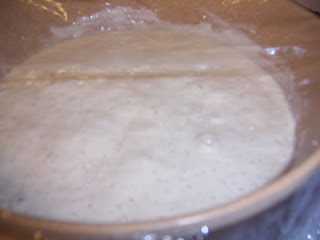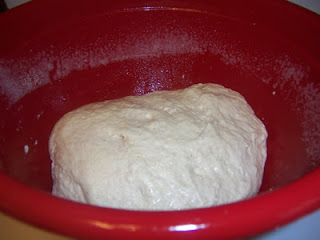Well, I found just the ticket - Potato Rolls! These rolls can be made up to a month in advance and frozen until ready to serve. When you're ready to serve them, all you have to do is thaw the rolls completely, and reheat them in foil until warm. I have an extra freezer so this turned out to be the better option. Making the rolls a few days ahead of time freed me up to do other things Thanksgiving morning and freed up space in my refrigerator. That's what I call a win-win!
These rolls were such a big help and a big hit that I decided to share them with you. I hope you enjoy them as much as we do. I'll definitely be making them again.
Potato Rolls
Recipe from Cooking Light
Makes: 24 Rolls

Directions:
Place potato in a medium saucepan; cover with water. Bring to a boil. Reduce heat; simmer 15 minutes or until tender. Drain in a colander over a bowl, reserving 1 cup cooking liquid. Mash potatoes with a fork. Cool reserved cooking liquid to 105° to 115°. Stir in 1 teaspoon sugar and yeast. Let stand 5 minutes.
You could use leftover mashed potatoes for this recipe, but then you wouldn't have the reserved potato water.
Lightly spoon 4 1/4 cups flour into dry measuring cups; level with a knife. Combine mashed potato, yeast mixture, 1 tablespoon sugar, 4 cups flour, butter, salt, and egg in a large bowl, stirring until well blended.
Turn dough out onto a floured surface. Knead until smooth and elastic (about 10 minutes); add up to 1/4 cup flour, 1 tablespoon at a time, to prevent dough from sticking to hands (dough will feel tacky). Place dough in a large bowl coated with cooking spray, turning to coat top.
Cover and let rise in a warm place (85°), free from drafts, 45 minutes or until doubled in size. (Press two fingers into dough. If indentation remains, the dough has risen enough.) Punch dough down; cover and let rest 10 minutes.
Divide dough in half; divide each half into 12 equal portions.
Working with 1 portion at a time (cover remaining dough to keep from drying), shape portion into a 2-inch-long oval on a floured surface.
Roll up tightly, starting with a long edge, pressing firmly to eliminate air pockets; pinch seam and ends to seal.
Place roll, seam side down, on a baking sheet coated with cooking spray. Repeat procedure with remaining dough portions, placing 12 rolls on each of 2 baking sheets. Sift 2 tablespoons flour over rolls to lightly coat.
Cover rolls and let rise 45 minutes or until doubled in size.
Bake at 350° for 10 minutes with 1 baking sheet on the bottom rack and 1 baking sheet on the second rack from the top.
Rotate baking sheets; bake an additional 10 minutes or until rolls are browned on bottom, lightly browned on top, and sound hollow when tapped. Remove from pan; cool on wire racks.

Then, the day you want to eat them, just reheat them and enjoy.
You might also enjoy using the leftover rolls to make miniature sandwiches with any leftover turkey. That's what we did and the sandwiches were really delicious!
Thanks for visiting The Bread Experience Bread-Baking Blog.






























































